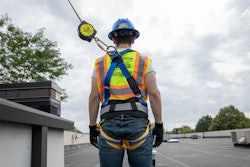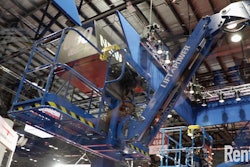
Aerial work platforms, such as articulating and telescopic booms and scissor lifts, are designed to carry personnel to elevated work locations. The number one priority on any aerial jobsite should be to promote a safe workplace for both the operators and the equipment. To do this, it's important for everyone onsite to follow safety rules and regulations set forth by industry agencies, such as OSHA (United States) and Provincial (Canada) authorities, ANSI (United States) and CSA (Canada), as well as those outlined in the equipment manufacturers’ guidelines.
It's important for articulated and telescopic boom operators to take proper precautions when exiting the boom platform at height. These booms are designed to allow operators to work at varying heights while remaining inside the platform. And, according to the Genie Operator’s Manual for booms, the operator should never enter or exit the platform unless the machine is in the stowed position and the platform is at ground level.
With that said, there are certain applications where it becomes necessary for the operator to exit an elevated boom platform to complete a task, such as when working on the wing of a plane or servicing a ride at an amusement park. OSHA and ANSI require an operator to be authorized in writing by the manufacturer before exiting a boom platform at height, and many manufacturers, including Genie, have developed an authorization letter that covers the process operators must follow for just such a need.
Follow specific rules and take special precautions
Before performing any operation that requires the operator to exit an elevated boom platform, make sure he/she is preauthorized from the equipment manufacturer to do so. With Genie equipment, this comes in the form of the “Exiting Elevated Boom Platform” letter.
This letter outlines owner, employer, user and operator responsibilities for exiting at height as well as detailing requirements for 100% tie-off and personal fall protection requirements. It's important to note that a copy of the authorization letter must be kept in the weather-resistant storage compartment located on the equipment at all times.
First and foremost, when an operator is on a project that requires exiting a platform at height, as with any boom application, he/she must be trained and qualified on how to safely operate the equipment and be familiar with that specific model. In addition to complying with all local, state, provincial or federal standards, the worker must operate the boom in accordance with the restrictions outlined in the authorization letter.
An approved full-body harness and appropriate lanyard must always be worn while working inside or exiting the platform. If a self-extracting lifeline/lanyard is used, it cannot allow more than 6 feet of free fall. Also, workers must enter or exit the platform only through the sliding mid-rail entry or gate provided, never climbing over the platform guardrails.
Types of fall protection
On articulated, telescopic and trailer-mounted booms, personal fall protection equipment, in addition to the platform guard rails, is required by OSHA in the United States and other regulatory agencies in many parts of the world. Fall protection equipment, such as a full-body harness and appropriate lanyard, is crucial for operator safety when working on aerial equipment. Personal fall protection can consist of a fall restraint and/or fall arrest system. Depending upon the height at which the work is being performed, either a fall restraint system or a fall arrest system should be selected and worn at all times while in the platform.
Because different types of aerial work platforms have specific requirements for fall protection, here’s what owners and operators need to know:
- Fall Protection Requirements on Manually Propelled and Scissor Lift Products — Standards for Manually Propelled Elevating Work Platforms and Self-Propelled Elevating Work Platforms do not require the use of personal fall protection equipment (PFPE) in addition to guardrails.
- Fall Protection Requirements on Booms — Use of approved PFPE, in addition to a guardrail for operator fall protection, is required in the U.S. and Canada for boom-mounted aerial platforms. All occupants in boom‐supported aerial work platforms must wear personal fall protection, with the lanyard attached to the designated anchorage, whenever they are in the platform. This requirement is mandated by the standards for Boom-Supported Elevating Work Platforms and Vehicle-Mounted Elevating and Rotating Aerial Devices and enforced by OSHA and Provincial authorities. If a user (typically the employer), or local jobsite or government regulations, requires an operator to use PFPE, Genie provides approved lanyard attachment points in every aerial work platform it manufactures.
- Personal Fall Protection Requirements on Boom‐Supported Aerial Work Platforms — The following is a general summary of fall protection requirements as discussed above for boom-supported aerial work platforms: An employer is responsible for providing approved fall protection for all employees/operators, and a personal fall arrest system used on a boom-type aerial lift cannot allow the operator to fall more than 6 feet, exceed 1,800 pounds arresting force or allow the operator to come into contact with any lower surface.
What this means is that the operator must determine the total fall distance by considering the following:
- Lanyard free fall distance
- Maximum allowable deceleration distance
- Maximum lock‐up length for the self-retracting lifeline or lanyard
- The height of the operator
- Safety factor (a suitable amount to ensure that the required clearance between the operator and the lower surface is met)
- Any stretch in the lifeline or lanyard outside of the deceleration distance
- Any harness effects
- Any movement of the platform due to dynamic loading
- Any obstructions under the platform
Whenever the occupant(s) of a boom platform are within the total fall distance range they are required to wear a fall restraint lanyard or 6-foot self-retracting lifeline. Once they have elevated above the total fall distance they can switch over to a 6-foot shock-absorbing lanyard to allow them to move about the platform. However, they must remember to switch back to the fall restraint lanyard before lowering the boom to under the total fall distance calculation. If occupants are wearing a 6-ft self-retracting lifeline, they are covered in both situations.
Unique requirements
When positioning the machine for entry/exit, the platform should be situated within 12 inches of the surface, and workers should not enter/exit the elevated platform in winds exceeding 20 mph. The operator must ensure 100% tie-off when entering/exiting the platform.
To ensure 100% tie-off, the operator’s primary lanyard must remain attached to the platform lanyard attachment point before exiting and attaching his/her secondary lanyard to the approved attachment point on the adjacent structure. Only then may the operator detach his/her primary lanyard from the platform. When returning to the platform, the operator must attach the primary lanyard to the platform anchor point before detaching the secondary lanyard from the adjacent structure.
The Genie guidance letter, for example, also allows the boom to be used as a fall restraint device. This enables operators to exit the platform to perform work on structures, if the pitch is no greater than 4:12 (18°), while using the boom platform as a tie-off anchor. For this application, the platform must be positioned a minimum of 4 feet from the leading edge of the structure. Also, a person trained in the operation of the Genie boom must remain on the ground near the machine base controls to prevent unauthorized use and to prevent the machine from being used.
The bottom line for when the need arises to exit a boom platform at height is to do so by following all the safety protocols. Always maintain 100% tie-off and only enter/exit the platform through the mid-rail entry or gate, never by climbing over the rail. And, get the preauthorization letter from the original equipment manufacturer, like Genie, to keep it on the equipment at all times.
Safe exit and work at height options
If the adjacent structure is not equipped to provide appropriate fall protection, a boom lift may be used as a fall arrest anchor. For example, all Genie 6- and 8-foot boom platforms come standard with eight approved lanyard attachment points. This allows an operator to work around the outside of the platform with a double lanyard system while maintaining 100% tie-off.
Even with these enhancements, Genie has continued to look for additional ways to meet customers’ safety and productivity requirements. Recently, a large amusement park customer contacted Genie and requested assistance with the development of a system that would allow their technicians to work around the outside of the platform without having to continuously attach and detach their lanyard. The result was the Genie Fall Arrest Bar. The Genie Fall Arrest Bar accessory is designed to specifically provide that extra productivity enhancement for operators when exiting the platform at height.
The Genie Fall Arrest Bar consists of a smooth, sliding, horizontal track design that allows the operator to tie off and move freely outside of the platform using a single 6-foot shock-absorbing lanyard. The enclosed track, made from high-strength steel, protects the trolley from weather and debris. The yellow, identifiable bar attaches quickly and easily, within 15 minutes, for fast setup and removal.
This boom option complies with ANSI and CSA standards for self-propelled booms and quickly attaches to a 6- or 8-foot platform on all 40-foot Genie telescopic booms and higher, as well as 45-foot Genie articulating booms and higher (with the exception of the Genie S™-125 HD model).
Adhere to the guidelines
To prevent incidents and mishaps from happening on an aerial jobsite, it's important to proactively make sure everyone in contact with an aerial work platform understands and adheres to all fall protection requirements.
Scott Owyen joined Genie in 1983 and has held key positions in manufacturing, training, product management and outside sales. Today, Scott serves as the Global Training Manager and focuses primarily on aerial work platform and telehandler operator safety training, train the trainer courses and product training. Scott was also instrumental in the development of the Genie Lift Pro Online Aerial Work Platform and Telehandler Operator Training Programs that have trained over 8,000 operators since they were launched.




















